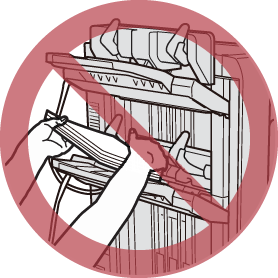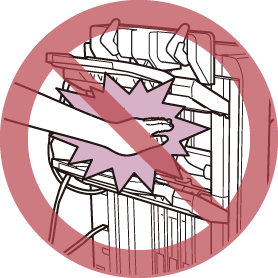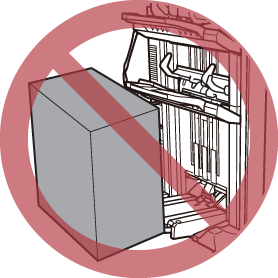

The output tray moves downwards during the print process to give space to the growing stack of output.
The workflow profile determines to which output trays PRISMAsync sends printed output. When an output tray has reached its limit, the printed output automatically goes to the next available tray. If all available output trays have reached their stacking limits, the printing process stops. Remove all printed output from the output trays. The output trays move upwards, and print process resumes.
Use the Settings Editor to turn high-volume stacking for the stacker / stapler on or off.
Do not place your fingers in the stacker / stapler when it is in use. This can cause personal injury or stacker / stapler damage.

When you remove paper from the output tray, do not place your hands on the output tray of the stacker / stapler. The output tray can move upwards and your hands can get caught.
Do not place your hands in the part of the output tray near the rollers where stapling takes place. This can cause personal injury.

Do not place objects onto the output trays of the stacker / stapler. This can damage the output trays.
Do not place objects under the paper trays of the stacker / stapler. This can damage the output trays.

For stacking with the stacker / stapler:
When the media weight is 326 g/m² - 350 g/m² (120 lb cover - 130 lb cover), use the lower tray to avoid that sheets stick together. In this case the maximum stack height is 40 mm (1.6 inch).
When rigid media with a weight of 326 g/m² - 350 g/m² (120 lb cover - 130 lb cover) is delivered in the lower tray, paper jams and scratches in high density images can occur.
For stapling with the stacker / stapler:
When the width of the media is small, the stapled sets can have uneven edges.
When stapled sets have coated covers, the staples can dirty the covers of sets on the output tray.
You cannot staple vellums, transparencies and labels.
For booklet making with the stacker /stapler:
You cannot make booklets of vellums, transparencies, prepunched paper, tab paper and labels.
When the cover weight is less than 64 g/m² (17 lb bond), the media can crease when saddle-stitched.
When the cover weight is less than 64 g/m² (17 lb bond), the booklets can get uneven edges when trimmed.
When the media size is small, the booklets can get uneven edges when saddle-stitched.
When the media size is small, the booklets can get uneven edges when trimmed.
When the covers use coated paper or insert sheets, the first page after the cover can stick to the back of the cover.
When the covers use coated paper or insert sheets, toner streaks can appear on the covers.
When the covers use coated paper or insert sheets, cracks can appear around the folds of the cover.